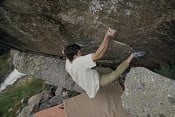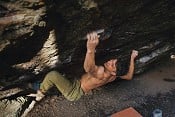
During late 2023 and early 2024, my approach to climbing was pretty serious. I wanted it to be that way. I'd found a series of projects which inspired me and pushed me to be better than I was, and I wanted to do what it took to climb them.
It wasn't that I had to go through hell to get there. I'm fortunate in that I get much satisfaction from the completion of a training plan focused towards a goal, and I'm more fortunate still that the training required is quite fun for me.
That being said, there were sacrifices which I made, some knowingly and some not. I chose a degree of social isolation for the sake of total autonomy. That way, I could make a plan to optimise my climbing and diligently stick to it without feeling as though I was letting anyone down. I developed a routine to my days through which I could settle into the training process and not question whether I was doing the right thing.
It was monotonous, but I was enjoying it. I saw steady progress on my board and on the rocks, and enjoyed the few sessions I shared with others. The moments I chose to spend with friends (mostly in a woodworking workshop of some good friends, who were helping me build some cabinets) felt especially nice. I felt settled, in what felt to be a quiet, steady time.
When my projects came into season. I maintained a level of routine. I often think of my performance phases as adventurous, filled with new people, new places, and many unknowns. This time, however, it was comfort and steadiness of routine that allowed me put the most energy into my climbing. It felt effective, and I was pleased with the approach I had. I focused on my performance in a deliberate and constructive way, but was able to enjoy the things which I didn't feel impeded that. And it paid off, I climbed what are likely the two hardest problems I've done.
It was only after the season ended that I realised I wanted a little more balance. There were elements of my approach to climbing in that time which felt valuable; it was a reminder of the effectiveness of systematic goal setting, and it gave me a deeper insight into the place from which I can best perform.
But there were also parts of my approach which felt limiting; I was distanced from many of my climbing friends and realised that, despite enjoying the comfort of familiarity of an area, I'd missed the exploration and adventure which my climbing travels used to provide.
So, I set to work reintroducing these things.
I never lost ambition in my climbing, but didn't really have anything long term to apply it to. I went looking, travelling the UK in my van with family and friends whilst exploring new areas and trying new projects. It was insanely fun. I didn't really know what I was looking for, so never felt lost looking for it. I think I had a time where I just enjoyed climbing on a shorter timeline, following my nose in terms of what felt fun each day, as opposed to what success would look like in a year's time.
If anything could epitomise adventure in my bouldering, I thought sailing to the US with no agenda would do it. For some time I'd spoken about the prospect of it with my friend, Seb, and the plan came together all of a sudden, just weeks before we were to set sail.
It felt spontaneous but I went for it. After two months of totally novel experiences whilst we stopped in Cabo Verde, Martinique, Panama, and then most of the countries in Central America as we switched from sail boat to public transport, I arrived in California.
I was exhausted but excited. The journey had worked out well, and had almost gone to plan. I'd been turned away at the border to Honduras due to a visa issue, and separated from the friends I was travelling with, but it only held me up for a few days before I was able to take a boat up the coast to El Salvador. It refreshed my faith that, with direction and a clear idea of where you're trying to get to, things tend to work out, even if not as smoothly as one would like.
Having taken my longest ever break from climbing, I was champing at the bit to get back to it, and even the first few weeks of training in a gym to get back into shape felt exciting and fun. It reminded me of the giddy, playful attitude I had to climbing when I first discovered it.
A few weeks later, winter set in and some cold, crisp conditions arrived in Yosemite. I migrated to the valley and my short training top up made way for a long season of climbing solely on rock. I didn't have much of a plan for my time in the US, but felt intrigued to see what Yosemite bouldering offered. I understood the conditions were fickle and the season was often short, heavy snows could stop play for weeks at a time.
Not so many people boulder in Yosemite, so with an excitement to climb with others and share some group trips, I'd anticipated that I would dip my toes in before moving elsewhere to more sociable areas. I wanted to follow my nose and climb on what felt motivating, what felt most fun, and what allowed me to climb with the people I wanted to climb with most.
Long story short, I barely left Yosemite for the whole winter. I'm glad I didn't. I came to the US looking for an adventure, but once I was in Yosemite I realised that I didn't want to be anywhere else. The Valley felt exciting, expansive, and full of unknowns, yet also small enough to feel familiar and comfortable. There wasn't a specific experience I was looking for, so to be in the place I wanted to be, with the people I wanted to be with, felt quite perfect.
My first session took me to The Dark Side (V16), a relatively new 8C+ established by Carlo Traversi the winter prior. The boulder is incredibly unique for one of its difficulty due to its low angle and technical sequence. The lower moves through some crimps suited me really well, and I actually reached the sloper section on my first try, but was abruptly humbled by how desperate it felt.
It's hard to know how position dependent a boulder is when you haven't yet found the positions. It can just feel like an impossible friction issue. I did all the moves quite quickly, which should - in theory - have given me confidence, but links seemed to rely so heavily on skin and friction that it almost felt intimidating. I didn't feel so confident, but what I didn't realise at that point was just how much more I had to learn about the movement, which would make falls less random. Indeed, the links grew quickly, and I became quite consistent.
Most of the time I was climbing with Randy (a local legend of the valley) and Katie (I'm sure by now that you've heard she's done it). The process of experimenting with methods and exchanging learnings was so fun that progression didn't feel all that necessary. But I did progress quite fast, it's really a style you learn to adapt to. I think it took me around six or seven days in the end.
It's a special climb, and one which challenged me in a way that other hard boulders hadn't. Beyond the lessons in how to move on granite, it also showed me a little of what I was looking for in this season. Firstly, it refreshed my excitement for the complex puzzling which comes with subtle moves, or moves hard enough that they require a deep dive into the details; in short, I was after a project! It also showed me how much I wanted to be climbing with others, the nice moments around the climbing, sharing methods and feeling invested in others' attempts.
It didn't take me long to find a project, in fact I had an open ended list of boulders I was excited to try. However, in Yosemite it's tricky to understand what it is that you're about to take on. When you start trying a climb, the nuances are inevitable, but it's hard to know when the nuance stops, when you need to stop learning and confront the physicality of a move, or the physics of friction. I got lucky in a way which only became obvious in hindsight.
I was alone in the valley during a spell of rainy days over Christmas. With things feeling a bit too quiet, I was determined to climb but hadn't yet discovered many lines which stayed dry throughout the rains. The two I knew of were iconic projects in Camp 4.
I'd shared a session on this wall with a few people during the early days of my trip, and had a little history lesson about those who had tried them. Real legends. The likes of Nalle, Jimmy Webb, Dave Graham… and I tried them that day with Carlo, and my friend Keenan.
Of the two lines, it felt obvious that the short problem on the right was quite possible. It felt hard, but the moves and positions made sense, and I solved all but the crux foot transition that day. I went back a week later and climbed it, naming it A Long Way for a Little Guy, graded around 8C or V15.
However, to the left sat a far more cryptic puzzle. The Six Degrees Project. A series of slashed edges trend leftwards up a scooped face. The holds were bad, but the feet were worse. With nothing to offer any opposition, the only options seemingly to contort into some brutally shouldery positions until you can will yourself to fly to the lip.
The first session didn't bear all that much fruit. I felt, as many before me seemed to have, out of my depth. I could hold some positions, but they felt so tenuous and, with what seemed like many equally terrible options, the prospect of moving between them felt beyond me.
I hadn't really expected to revisit it, but during this wetter spell I had some long sessions of holding positions, trying different feet and experimenting with new methods. The difficulty was perfect, actually, I never made any huge improvements, but I made slow and gradual progress. A move would feel slightly more probable or a position slightly more stable. It kept me encouraged and excited to go back, and yet I never had any expectations that I would do it on any given day.
I'd found a project, and an ambitious one at that! However, it was so physical that I couldn't try it all that often, and it wasn't something that others were flocking to try with me. So, alongside this, I began cleaning and trying new lines with Katie and Randy. I supported them on their projects on my rest days, and found a nice balance of sociable sessions and projecting deep dives, all in one of the most beautiful places on earth. So, there wasn't much reason to leave.
When the Six Degrees Project began to come out of season (you want it especially cold for that one), a new project presented itself. This time an extremely long and savagely crimpy face which felt similarly ambitious to me, but in a completely different style. Similarly, as this one came out of season, the same thing happened again.
So, most of my time and focus was put into understanding these three projects. I never felt close to any of them, but that wasn't really what I was looking for. It could've been pure fortune that I was able to find these projects, at what felt like the exact level I wanted, but I think it likely speaks more to the endless potential of the place.
There was a nice cadence to my winter. Dispersed between trying these main projects, there were a number of new lines I worked on, some of which I could do in a session, many which took me a few days. Regardless, I always felt satisfied. The variation in style meant that I was continually working on things I struggled with, whilst also having fun occasionally flexing my front-step-small-crimp party trick.
I climbed a lot of new boulders, on established classics and new lines alike and, despite not climbing any of my main projects, it felt like a fruitful season. Perhaps partly due to the boulders I did, but mostly for discovering a bit of balance in my climbing. An expanded understanding of the fun I could have would only compliment the degree of focus I could then apply to my projecting.
I'm now training for next winter. To do any of the climbs I worked feels like a tall order, let alone the prospect of doing all of them. However, I don't feel worried, nor disappointed by my inability to do them this year. To realise their potential felt like a huge step in my climbing, and to adopt this newfound attitude, balancing the fun and the focus, feels like a long term asset that I'll value more than the completion of any climb.





























Comments
Nice read, glad you’ve found your psych in a beautiful place.
think there’s a typo in the first line, should it be late 2023 and early 2024?
Cheers, have updated that!
it’s been lovely to hear aidan talking about his time in yosemite on his and sam prior’s podcast, and it’s just as delightful to read him on it.